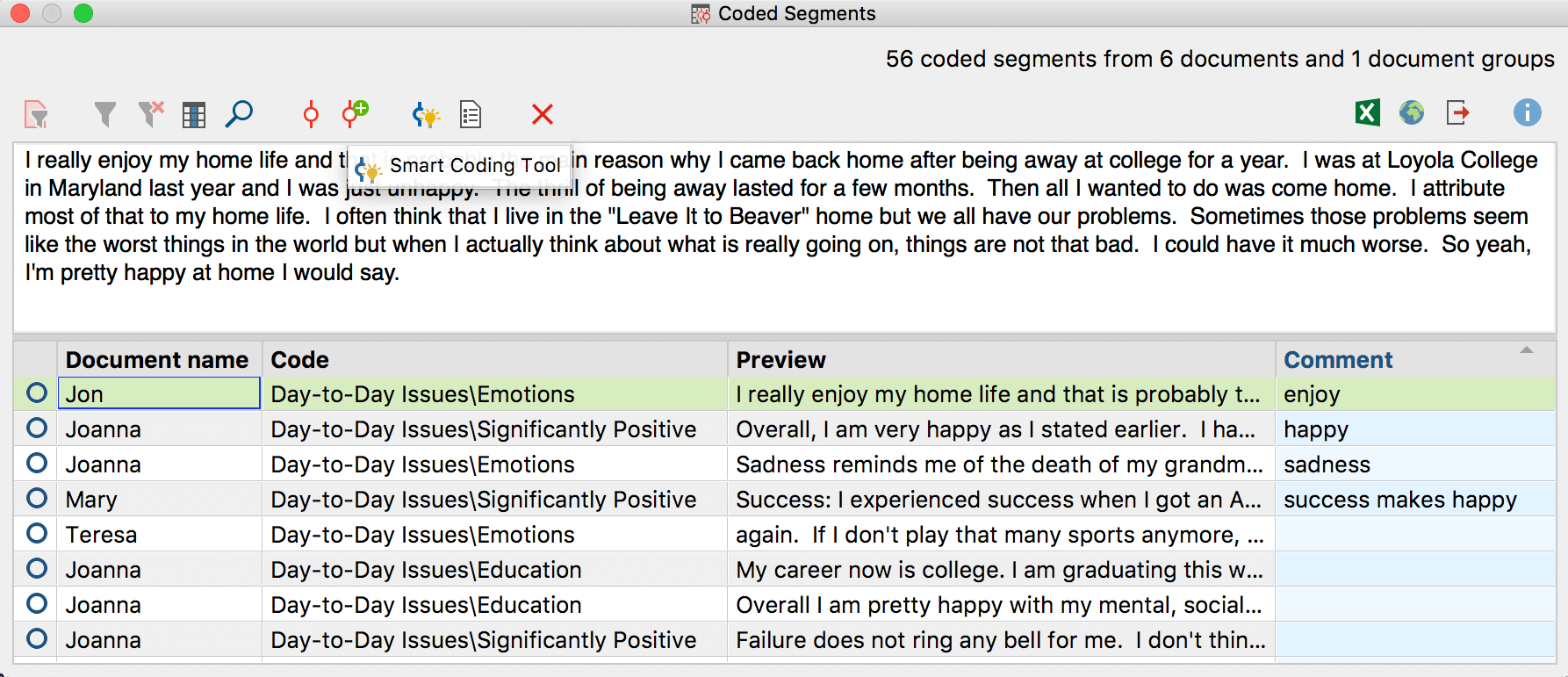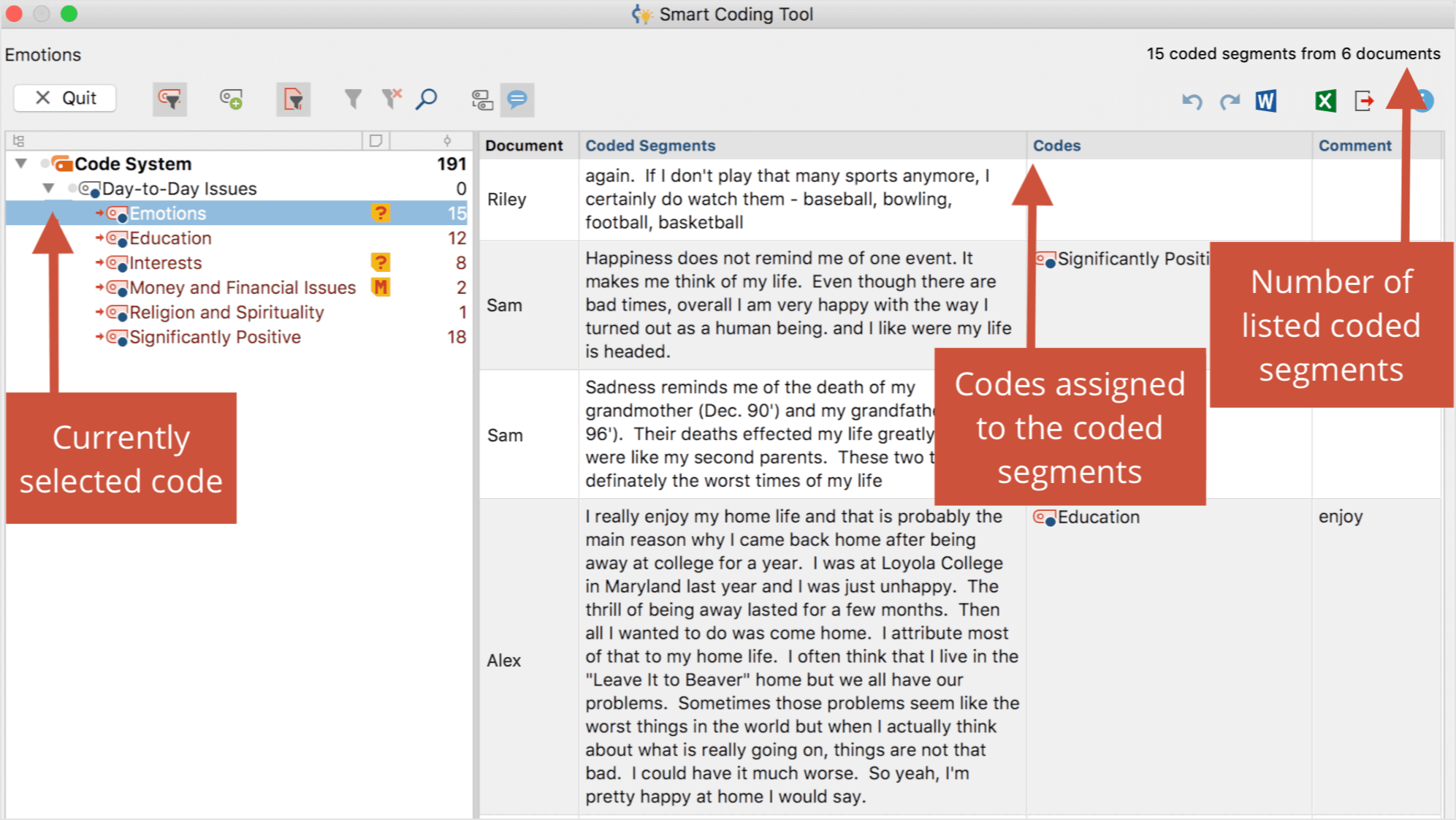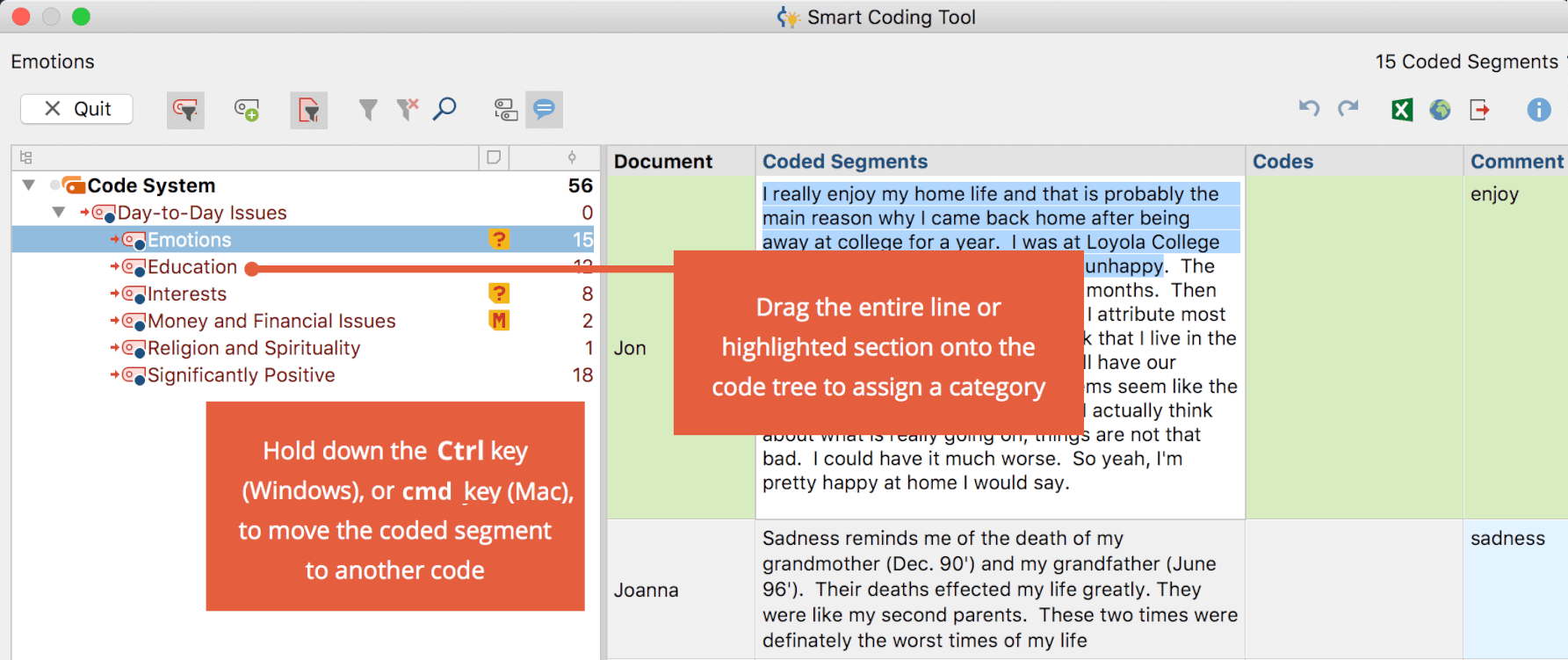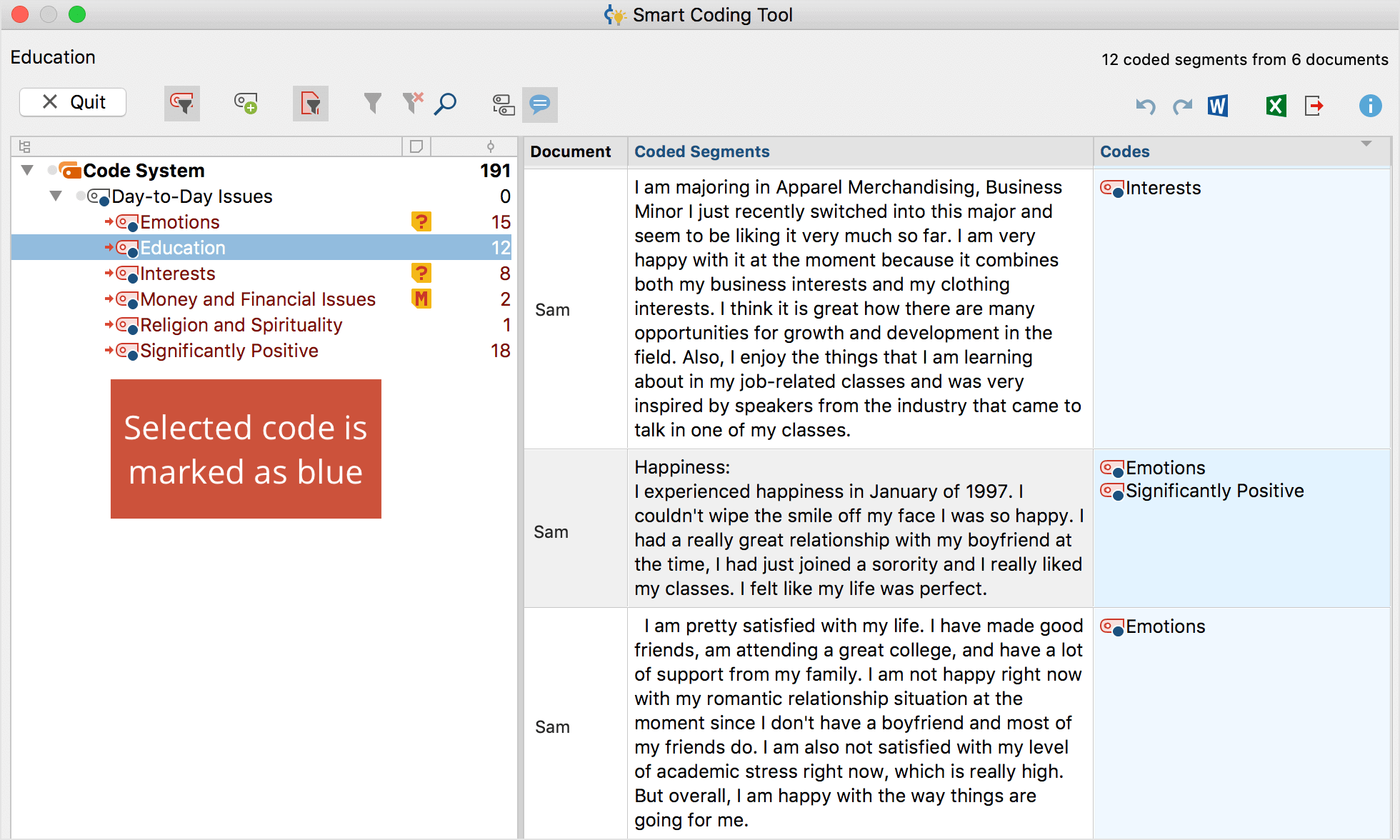The Smart Coding Tool is designed for working with coded text segments and is very well suited to performing the following tasks:
- Getting an overview of the contents of a category,
- Reviewing and, if necessary, changing relevant categories,
- Customizing your categorization system(s), particularly differentiating (i.e. breaking down) parent-codes or aggregating codes.
The Smart Coding Tool is always used to compile coded segments and can therefore be opened in two places. By clicking on the Smart Coding Tool icon: ![]()
- in the “Retrieved Segments” window or
- the Overview of Coded Segments.

The Smart Coding Tool will open immediately after you click on the icon.

The table window is divided into two display areas. A reduced code system is displayed in the left area. When you open the Smart Coding Tool, only the codes assigned to the compiled coded segments will be displayed in the code system. So that the hierarchical structure can be retained, sometimes non-activated parent codes are also displayed. The number at the end of a code row in the system indicates how often the code appeared in the selected documents.
In the right area, the coded segments are listed in a table. The segments whose code is selected in the hierarchical list on the left and highlighted in blue will always be shown here. The code that is currently selected is displayed in the upper left corner. At the top right, you can see how many coded segments (from how many documents) are displayed in the table, that is, how many rows the table contains. When the Smart Coding Tool is opened, only the documents from which the compiled coded segments originated will be activated. Only their coded segments are displayed.
The individual columns in the table contain the following information:
Document – The source document in which the coded segment is found
Coded segments – The coded segments of text, images and PDFs
Codes – The list of codes assigned in the area of the displayed coded segment. It doesn't matter whether the code has only been assigned to one character of the segment, the entire segment, or even beyond the boundaries of the segment. Only the codes that are visible on the left in the code system are listed. So that the code name is not listed repeatedly in the column when a code is broken down into its subcodes, the parent code of the displayed coded segment is not displayed.
Comments – A text field that can be freely edited (max. 255 characters) to add comments to coded segments.
Like all MAXQDA table widows, the individual areas can be adjusted: the columns can be adjusted in width and position with the mouse, or hidden with a right-click on a column heading. A click on the heading sorts the column in ascending order, another click in descending order.
When starting the Smart Coding Tool from the "Retrieved segments" window, the weight filter is ignored. Therefore, if segments were not displayed in the "Retrieved segments" due to the weight filter, they will still appear in the Smart Coding Tool.
Symbol toolbar
Along the top edge of the window you will see a toolbar containing the following options:
![]() Quit – closes the Smart Coding Tool. Alternatively, you can click the X to close the window.
Quit – closes the Smart Coding Tool. Alternatively, you can click the X to close the window.
![]() Only activated codes – restricts the display of the code system to the activated codes only. This option is selected automatically when you open the Smart Coding Tool. When turned off, all your codes and subcodes are displayed.
Only activated codes – restricts the display of the code system to the activated codes only. This option is selected automatically when you open the Smart Coding Tool. When turned off, all your codes and subcodes are displayed.
![]() New code – creates a new subcode in your code system. The new codes are always displayed at the bottom as the last subcode.
New code – creates a new subcode in your code system. The new codes are always displayed at the bottom as the last subcode.
![]() Only activated documents – restricts the display of coded segments to those in currently activated documents. The display of frequencies in the code tree is adjusted accordingly.
Only activated documents – restricts the display of coded segments to those in currently activated documents. The display of frequencies in the code tree is adjusted accordingly.
![]() Filter – applies the filters you can define by right-clicking on the column heading and selecting Set filter.
Filter – applies the filters you can define by right-clicking on the column heading and selecting Set filter.
![]() Reset all filters – removes all filters from all columns.
Reset all filters – removes all filters from all columns.
![]() Display search toolbar – lets you to enter a search term to search for text in all or specific columns.
Display search toolbar – lets you to enter a search term to search for text in all or specific columns.
![]() Display parent code – in addition to the code, the "Codes" column also displays its parent code.
Display parent code – in addition to the code, the "Codes" column also displays its parent code.
![]() Display comments – displays the “Comments“ column.
Display comments – displays the “Comments“ column.
![]() Undo – undoes the last action in the Smart Coding Tool.
Undo – undoes the last action in the Smart Coding Tool.
![]() Redo – redoes the last action in the Smart Coding Tool.
Redo – redoes the last action in the Smart Coding Tool.
Create new code
You can always add new codes to use to code selected segments:
- Click on the New code
- In the dialog window that appears, enter your new code name and, if necessary, assign a code color. You can also enter a description of the new code in the "Code Memo" text box.
- Click on Add code if you want to add further codes. Click on OK to finish creating new codes.
Newly created codes are automatically activated so that these are displayed in the code system.
Assign a code
To assign a code to a coded segment, click and drag the line of the code to one of the displayed codes in the code system. The newly assigned code is then immediately displayed in "Codes" column. To code only part of a coded segment, first double-click on the whole coded segment text, then select the portion of text you want to code, and drag it to one of the codes in the code system. Even if you assign the same code to several sections of a coded segment's text, the code name will only be listed once in the "Codes" column.
If you hold down the Ctrl key (Windows) or cmd key (Mac) while dragging-and-dropping a whole line onto a code, the complete coded segment is moved to the selected code. It will thus no longer be displayed.

Remove assigned codes
To remove an assigned code, click the "X" that appears when you move the mouse over a code in the "Codes" column. All assigned codes are then removed from the coded segment.

Customize your code system
Your code system can be customized throughout the entire analysis process. You can change the order of codes with the mouse and even insert them as sub-subcodes. By right-clicking on a code, all the functions from the overall "Code System" are available to customize your code system in this window:
- Delete code
- Sort subcodes (alphabetically or by category frequency)
- Change code color
- Create or edit code memo
Click a code in the code system to list all the segments coded with this code. This way you always have an overview of the contents of your individual categories. The selected code in the code system is highlighted blue. The name of the selected code is also displayed at the top of the window.

Moving or copying individual coded segments
By default, if you drag a coded segment onto a code, that code will be assigned to the segment in addition to other previous codes assigned to it. The segment will still be coded with the code whose other segments are displayed in the right window.
If you hold down the Ctrl key (Windows) or cmd key (Mac), however, while dragging a coded segment to a code, the code will be replaced. That is, the code whose segments are currently listed in the right window is removed and the segment you dragged to a different code disappears from that list.
This function is e.g. especially useful if you want to transfer a code from one subcode to another subcode, because it suits it better in terms of content.
Moving or copying several coded segments
To move or copy all segments of a code to another code, right-click on a code and select the function Move Coded Segments or Copy Coded Segments in the context menu.
Then right-click on the target code and select the corresponding function: Move Codded Segments from 'Code xy' or Copy Coded Segments from 'Code xy'. For more information on this function, refer to the section Move or copy all coded segments of a code.
Working with comments on coded segment
In the comments column you can write a comment regarding each coded segment. The comments are stored as Coded Segment Comment for the code selected in the code system and highlighted in blue.
In comments field, you can add comments about the coded segment texts, ideas for new categories, and more. They are also suitable for keeping track of your analytical procedure (i.e. "still unclear“ – "come back to this again later") or for other team members ("please cross-check this!").
Double-click on a cell in the "Comments" column to enter a new comment or edit an existing one.

Export your display
Your current display can be exported via the usual icons at the top right of the window. All the rows (coded segments) in the right field are always exported.
![]() Open as Word document – Creates a Word document and opens it.
Open as Word document – Creates a Word document and opens it.
![]() Open as Excel spreadsheet – Creates an Excel spreadsheet and opens it.
Open as Excel spreadsheet – Creates an Excel spreadsheet and opens it.
![]() Export – Creates a table (XLSX), a text document (DOCX) or a website (HTML).
Export – Creates a table (XLSX), a text document (DOCX) or a website (HTML).
